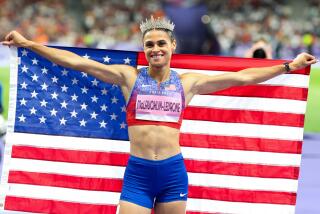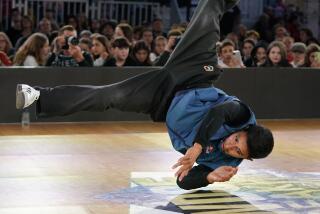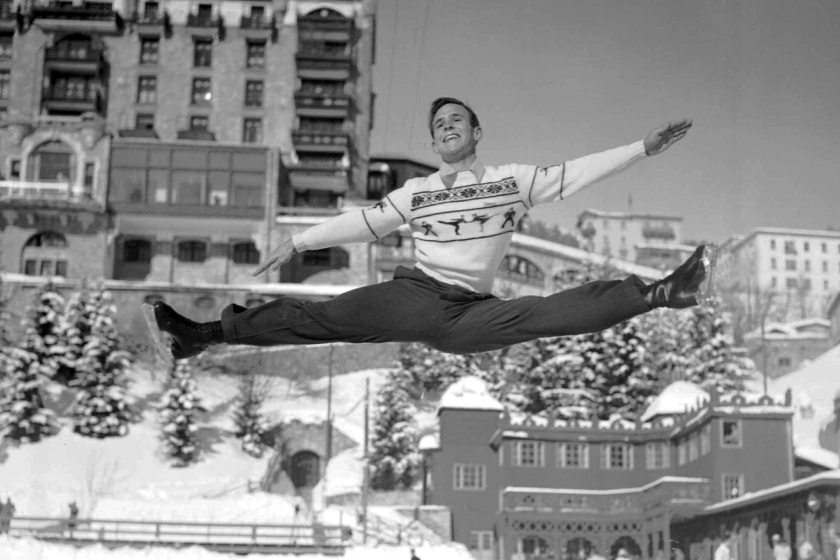Theater of the ABSURB
- Share via
Of all the huckstering publicity stunts, once-in-your-lifetime promotional gambits and quick-strike money grabs ever foisted on the American sports fan, today’s Michael Johnson-Donovan Bailey “World’s Fastest Man” showdown in Toronto slots somewhere between Bobby Riggs swatting backhands against Billie Jean King and Jesse Owens racing a horse.
The Riggs-King “Battle of the Sexes” tennis match in 1973 was a gimmick with a shelf life, a hustle that actually impacted its era. King’s victory, witnessed by tens of millions of television viewers, legitimized women’s athletics in the eyes of many previous doubters and helped trigger the U.S. tennis boom of the 1970s.
Owens vs. the nag-of-the-week was a different matter, a sideshow that debased the reputation of a four-time Olympic champion.
After his historic triumphs at the 1936 Olympic Games, Owens earned a few dollars by racing horses at carnivals--races that were rigged by firing the starter’s pistol so close to the horse’s ear that the startled horse would rear, allowing Owens to break out to insurmountable head starts.
Johnson versus Bailey won’t be that shameless--unless Bailey falls behind and slide-tackles Johnson, you never know--but it won’t change history, either. It is gimmicky, for sure--a sprint of 150 meters, splitting the difference between Bailey’s specialized distance of 100 meters and Johnson’s 200. But it has piqued the public’s interest, and should hold its attention for at least 14.60 seconds, which is better than U.S. track and field does in most non-Olympic years.
“I, first and foremost, am a track and field fan,” sprinter Ato Boldon says. “And I am tired of hearing the purists say, ‘Oh, 150 meters is unpure.’ I believe any kind of headway we can make in making this sport better recognized is a good thing. I wouldn’t care if they ran 20 meters.”
Al Franken, a track promoter for nearly 40 years, agrees.
“I think it’s a marvelous idea,” Franken says. “Track is a damn good sport that suffers from a lack of promotion. . . . If you’re ever going to build the sport up again, you have to get the non-track people interested. You have to get the media excited, you have to get the public excited. And to do that, you need a hook.”
In that respect, Johnson and Bailey are following the spike marks of a tradition at least as old as P.T. Barnum, its gospel grounded in the birth rate of suckers.
The basic concept: to fool enough of the people just one time--and hope the TV numbers cover costs.
The hook is usually a variation of the same theme: Who’s the faster/stronger between man/man’s nemesis, man/woman, man/beast, man/machine or ABC/NBC in “The Battle of the Network Stars.”
A lot of not-so-hallowed ground was traveled to get us to today’s 150 meters. If you think there’s nothing new under SkyDome’s roof, you’re absolutely right.
Some of the PR stunts of the past that made this afternoon’s $2-million runoff possible, if not any less unpalatable:
Stunt: Jesse Owens and his horse races.
The hook: Just how fast is the world’s fastest human?
The lowdown: There being no pay-per-view or $4-million European track meet purses in Depression-ridden 1936, Owens returned home from his heroic achievement in Berlin to a series of odd jobs, running 100-yard dashes against horses among them. It was no way to treat a sprinting legend who had just won four gold medals before the wincing eyes of Adolf Hitler, but, hey, a buck’s a buck.
Lasting impact, for better or worse: Sixty years later, champion Olympic sprinters race each other for a seven-figure prize with no fear of being trampled.
Stunt: Bob Feller tries to outgun a speeding motorcycle.
The hook: Just how fast is the world’s fastest fastball?
The lowdown: Feller, the Nolan Ryan of his day, had just thrown a no-hitter against the Chicago White Sox to open the 1940 season. Abuzz over the performance, the city of Chicago arranged for a showdown between Feller and a motorcycle policeman on a Harley-Davidson in Lincoln Park. The Harley was revved and already 13 feet off the starting line when Feller released his pitch--a heater that beat the motorcycle to the target. With the cycle going 85 mph, the speed of Feller’s fastball was estimated to be 104 mph.
Lasting impact, for better or worse: Development of the speed gun makes timing Randy Johnson’s fastball somewhat less problematic today.
Stunt: Joan Joyce versus Ted Williams.
The hook: See the world’s best women’s softball pitcher face the Splendid Splinter.
The lowdown: Joyce, who struck out 5,677 batters in her career with the Raybestos Brakettes, drew this assignment in 1961, a year after Williams had retired from the Boston Red Sox with a lifetime batting average of .344. Joyce won this fast-pitch duel, striking out Williams several times before Williams, after 15 minutes, flung his bat aside in disgust.
Lasting impact, for better or worse: None to speak of. Williams still made the Hall of Fame, women’s softball has yet to shed its fringe-sport status--even though the feat was duplicated in 1981, when Kathy Arendsen struck out Reggie Jackson three times in the Carrier Dome in Syracuse.
Stunt: Bobby Riggs versus Billie Jean King.
The hook: Tennis’ “Battle of the Sexes.”
The lowdown: Hustler extraordinaire Riggs was 55 when he goaded King, then the best female tennis player in the world, into this best-of-five sets spectacle in the Astrodome in 1973. Earlier that year, Riggs had humiliated Margaret Court, 6-1, 6-2, in a match that served as the lure for King, who had been ignoring Riggs’ male chauvinist tauntings for years. The 29-year-old King finally agreed to a $100,000 winner-take-all encounter on Sept. 20, 1973, a shrewdly hyped he-served/she-returned showdown that attracted a television audience of more than 40 million. King won in straight sets, 6-4, 6-3, 6-3--a triumph tennis historian Ted Tinling described as “probably the most important event in the history of women’s tennis.”
Lasting impact, for better or worse: For once, something meaningful was accomplished. Tennis developed into a major sport in the United States and the charismatic King became a world figure who transcended sports, an icon in the 1970s feminist movement.
Stunt: Ruffian versus Foolish Pleasure.
The hook: Horse racing’s “Battle of the Sexes.”
The lowdown: The undefeated filly Ruffian was pitted against the reigning Kentucky Derby champion in a 1975 match race that ended tragically. Midway through the milelong run at Belmont Park, Ruffian broke down, shattering her right front leg, and was unable to finish. After one failed attempt to surgically repair the broken leg, Ruffian, described at the time as “the greatest filly ever,” was given a fatal injection and buried the next day in the Belmont infield.
Lasting impact, for better or worse: Ruffian’s injury shocked and outraged a national television audience, a reaction that helped to prompt advances in equine medicine. Twenty years later, many horses with broken legs are saved for breeding through arthroscopic surgical procedures.
Stunt: George Foreman fights five men in one night.
The hook: How many tomato cans can a former heavyweight champion crush in 15 rounds?
The lowdown: Foreman was still stinging from his 1974 loss in Zaire to Muhammad Ali when Don King foisted this debacle on the boxing world a year later. The idea was for Foreman to prove he was the “true champion” by knocking out five men on the same night.
King lined up five stiffs, including a 40-year-old who hadn’t fought competitively in 9 1/2 years, for a succession of three-round bouts. Foreman knocked out four of them before the last bout degenerated into a free-for-all in the ring involving handlers from both corners.
“There you have it, ladies and gentlemen,” Howard Cosell intoned from ringside, “the human condition at its lowest ebb.”
Lasting impact, for better or worse: Wrestlemania.
Stunt: Muhammad Ali versus Antonio Inoki.
The hook: A champion boxer or a champion wrestler--Quien es mas macho?
The lowdown: For $6 million, Ali agreed to quasi-fight Inoki in Tokyo in 1976. It was a farce from the moment the contracts were signed--on his arrival for the bout, Ali told Japanese reporters that the script called for Inoki to win. The resultant furor led to a rewrite, with the 15th round ending with Inoki on his back, kicking at Ali’s thighs, en route to a ludicrous “draw.”
Lasting impact, for better or worse: “Rocky” sequels.
Stunt: Jim Brown versus Franco Harris.
The hook: Can a bitter, long-retired NFL Hall of Famer adequately vent his frustrations on a younger man chasing his rushing record by beating the impudent challenger in recreational sports and a 40-yard dash?
The lowdown: As a 34-year-old Harris was bidding to eclipse Brown’s rushing record in the 1984 NFL season, a 48-year-old Brown began harping about Harris--that Harris wasn’t tough enough, good enough to hold such a prestigious record, that sort of thing.
By January 1985, Harris had heard enough--and consented to meet Brown in four pointless competitions. Brown beat Harris in basketball and racquetball, Harris rallied to win in one-on-one football and the 40-yard dash, outjogging Brown, 5.16 seconds to 5.72.
Lasting impact, for better or worse: By the time Brown and Harris actually competed, Walter Payton, not Harris, had broken Brown’s record, so why bother? Twelve years later, no one has been able to produce a logical answer.
Stunt: Kareem Abdul-Jabbar goes one on one with Dr. J.
The hook: Old guys who used to be great play hoops on pay-per-view.
The lowdown: Initially, the plan was for Julius Erving to promote a one-on-one match between longtime rivals Abdul-Jabbar and Wilt Chamberlain in 1992, but when Chamberlain declined the invitation, Dr. J stepped in as a replacement.
Abdul-Jabbar was 44, Erving 42 when they met in Atlantic City, N.J., and they looked very much their ages. Dr. J missed 35 of 44 shots and Kareem ground out a 41-23 victory. Pay-per-view numbers were even less scintillating. The event, purchased at $19.95 by 55,000 households, grossed only $1.2 million.
Lasting impact, for better or worse: After the game, Kareem and Dr. J agreed to stay retired.
And what of Johnson-Bailey?
Will their 150-meter sprint truly determine the “World’s Fastest Human,” for those who care about such matters?
“No,” Franken says flatly. “It’s just good showmanship. It’s like a skins game. No one remembers who won it. They just know someone won $300,000 or $400,000 and had a good time.”
(BEGIN TEXT OF INFOBOX / INFOGRAPHIC)
The Matchup
Tale of the tape for Michael Johnson and Donovan Bailey, who meet in a 150-meter match race at SkyDome today (event distances in meters):
*--*
BAILEY Category JOHNSON 29 Age 29 6-0 Height 6-1 181 Weight 175 100 Best Event 200-400
*--*
CAREER HIGHLIGHTS
BAILEY
* Olympic champion--100 and 400 relay, Atlanta, 1996.
* World champion--100 and 400 relay, Goteborg, 1995.
* World records--100 (9.84 seconds), Atlanta, 1996; 50 indoors (5.56 seconds), Reno, 1995.
JOHNSON
* Olympic champion--200 and 400, Atlanta, 1996.
* World champion--200 and 400, 1,600-meter relay, Goteborg, 1995.
* World records--200 (19.32 seconds), Atlanta, 1996; 400 indoors (44.63 seconds), Atlanta, 1995.
More to Read
Go beyond the scoreboard
Get the latest on L.A.'s teams in the daily Sports Report newsletter.
You may occasionally receive promotional content from the Los Angeles Times.






